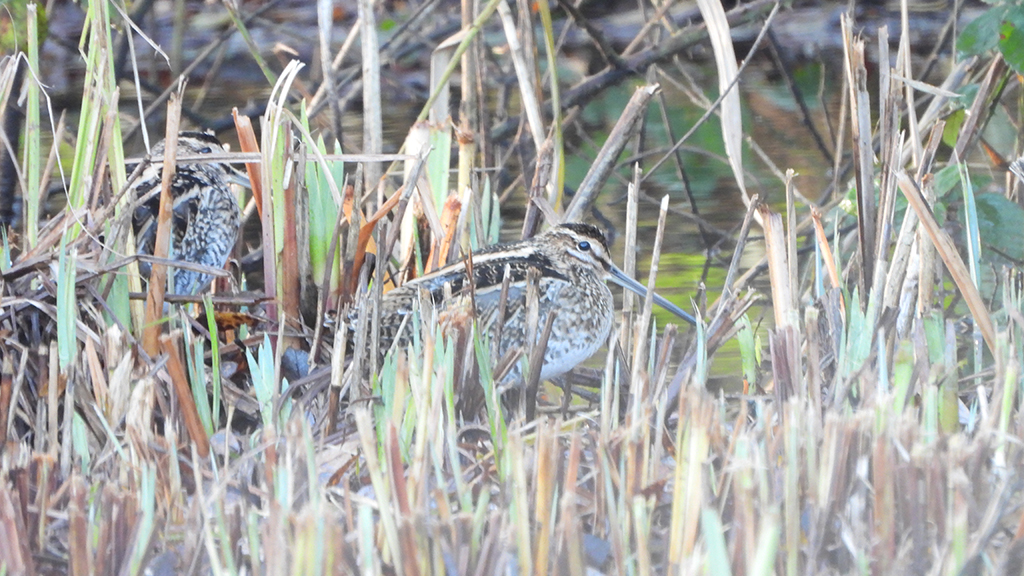Wildlife sightings for 10th September 2013
2 Garganey - wader scrape
5 Snipe - main lake, wader scrape
40 House Martin - feeding over sheltered lagoon, reservoir lagoon, main lake
15 Sand Martin - feeding over sheltered lagoon, reservoir lagoon, main lake
2 Blackcap - sheltered lagoon
5 Chiffchaff - South route, wildside
Recent bird highlights: Garganey, Black Tern, Buzzard, Goshawk, Saker-type Falcon hybrid, Peregrine, Hobby, Ruff, Greenshank, Green Sandpiper, Common Sandpiper, Yellow Wagtail, Wheatear, Garden Warbler, Whitethroat, Lesser Whitethroat, Linnet.
Shoveler, Gadwall and Teal continue to arrive on autumn migration, and a good selection of wader species has been recorded throughout. Migration really began to pick up towards the end of August with good numbers of Willow Warbler and Chiffchaff coming through, along with sightings of passage Garganey (a juvenile bird), Whitethroat, Lesser Whitethroat, Swallow, Wheatear and Yellow Wagtail. Wader passage should continue to improve as we move further into September.
Butterflies and other invertebrates: Butterfly transect 2nd September 2013: Small White (20) > Green-veined White (10) > Common Blue (7), Speckled Wood (7) > Large White (6) > Meadow Brown (4) > Comma (1), Small Tortoiseshell (1)
Dragonfly transect 2nd September 2013: Migrant Hawker (51) > Small Red-eyed Damselfly (26), Common Darter (26) > Azure / Common Blue Damselfly (9) > Brown Hawker (5) > Ruddy Darter (4) > Blue-tailed Damselfly (1), Southern Hawker (1)
Clouded Yellows are still being encountered on site at the moment: 2 on the marsh 3rd September.
In addition to the healthy range of Orthoptera species seen on site so far this year, two more species (Oak Bush-cricket and Slender Groundhopper) can also be added to the previous week’s list: Speckled Bush-cricket, Long-winged Cone-head, Roesel’s Bush-cricket, Dark Bush-cricket, Common Groundhopper, Common Green Grasshopper, Meadow Grasshopper, Field Grasshopper and Lesser Marsh Grasshopper. Whilst most of the bush-crickets and grasshoppers seem to be ratcheting up their stridulating serenades, some – like the Common Green Grasshopper – appear to be noticeably less audible. However, one was definitely present in the Overflow Car Park on Tuesday – the sound, likened to a free-wheeling bicycle, was certainly audible in the grassland adjacent to the car park ditch.
Water voles: actively feeding in the Wildside ponds in particular (listen out for the very audible munching from the base of marginal aquatic plants like Branched Bur-reed and Greater Pond Sedge). They also often make a distinctive ‘plop’ sound as they leap into the water from the channel edge.
Reptiles: Common Lizards have been seen on log piles on the South Route and pond zone; also around the brick edges of the sluices if quiet enough. Slow Worms are present below the survey tins and sometimes basking on habitat piles. Grass Snakes may be spotted swimming across ponds in wildside.
Flowering plants: Square-stalked St.John’s Wort, Blue Water-speedwell, Branched Bur-reed, Cat’s-ear, Common Mallow, Common Sorrel, Field Scabious, Devil’s Bit Scabious, Great Bird’s-foot Trefoil, Great Burnet, Salad Burnet, Hemlock Water-dropwort, Hop Trefoil, Lesser Swinecress, Mare’s-tail, Meadow Buttercup, Red Clover, Scented Mayweed, Scentless Mayweed, Short-fruited Willowherb, Smooth Hawk’s-beard, White Clover, Wild Clary, Wild Thyme, Yellow Iris, Yellow Water-Lily, Purple Loosestrife, Yellow Loosestrife, Valerian, Fleabane, Meadowsweet.
Bats: Soprano Pipistrelle >> Daubenton’s Bat, Leisler’s Bat > Noctule, Common Pipistrelle.



